Key findings
Boris Johnson has announced two main tax proposals – to increase the income tax higher rate threshold (HRT) from £50,000 to £80,000, and to raise the point at which people start paying National Insurance contributions (NICs). We find that:
- Increasing the HRT costs about £9 billion and benefits the 4 million or so income taxpayers with the highest incomes. Most of the gain goes to those in the top 10% of the income distribution would gain an average of nearly £2,500 a year. The biggest gainers will actually be high income pensioners as they won’t be affected by the accompanying increase in the NI ceiling.
- While only about 8% of individuals would gain from this change in the short run, probably at least a quarter will at some point be higher rate taxpayers themselves, or will live in a household with a higher rate taxpayer, at some point in their lives.
- Raising the HRT to £80,000 straightaway would take about 2.5 million people out of higher rate tax, taking the number of higher rate taxpayers down to its lowest level since 1990. This would constitute a major change to our income tax system.
- Increasing the point at which people start to pay NICs is probably the best thing one can do through the tax system to help low earners, though even this policy offers most benefit to higher earners. Increases in tax credits would be significantly more effective if the main intention is to help low earners in low income households.
- Increasing the floor is expensive though, costing at least £3 billion a year for each £1,000 that is raised. Raising it to the current income tax personal allowance of £12,500 would cost at least £11 billion and would take £2.4 million workers out of NICs altogether.











